Abstract
In some families of flowering plants, a single self-incompatibility (S) locus prevents the fertilization of flowers by pollen from the same plant. Self-incompatibility of this type involves the interaction of molecules produced by the S locus in pollen with those present in the female tissues (pistil). Until recently, the pistil products of the S locus were known in only two families, the Brassicaceae (which includes the cabbages and mustards) and Solanaceae (potatoes and tomatoes). A paper in this issue of the Proceedings describes the molecules associated with self-incompatibility in a third family, the Papaveraceae (poppies). We review current research on self-incompatibility in these three families and discuss the implications of the latest findings in poppy on the likely evolution of self-incompatibility in flowering plants. We also compare research into self-incompatibility with recent progress in understanding the mechanisms by which plants overcome infection by certain pathogens.
Full text
PDF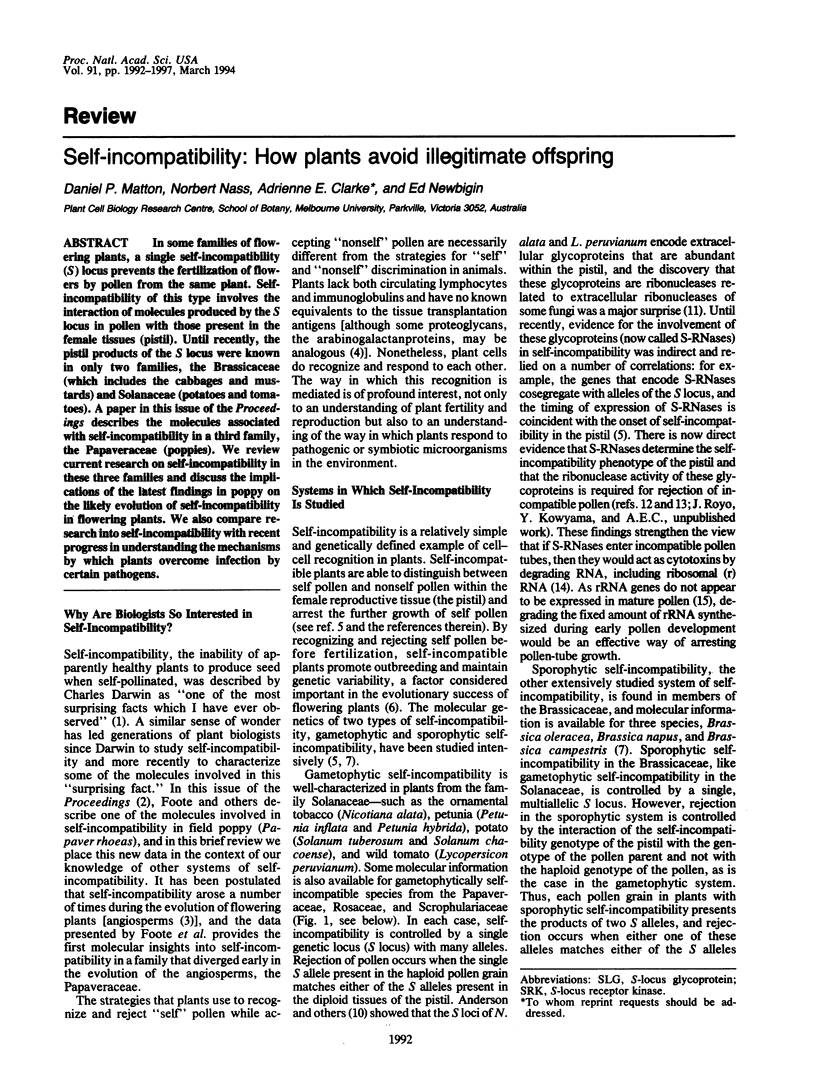
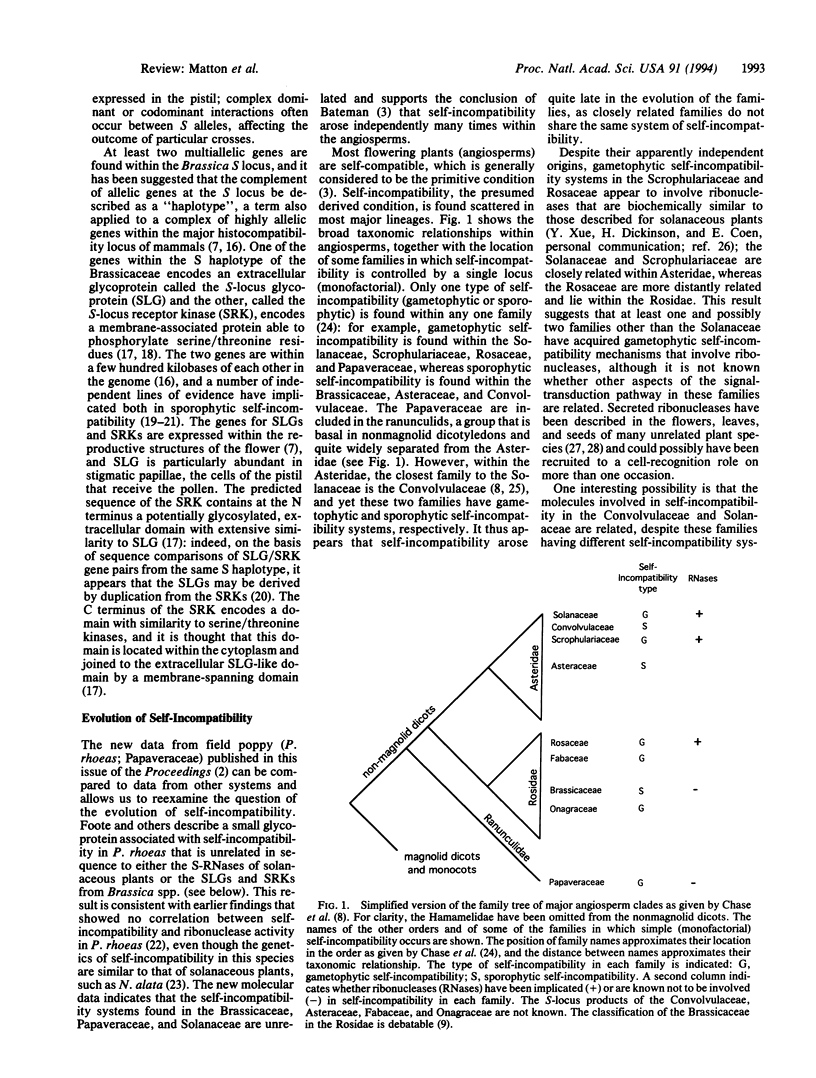
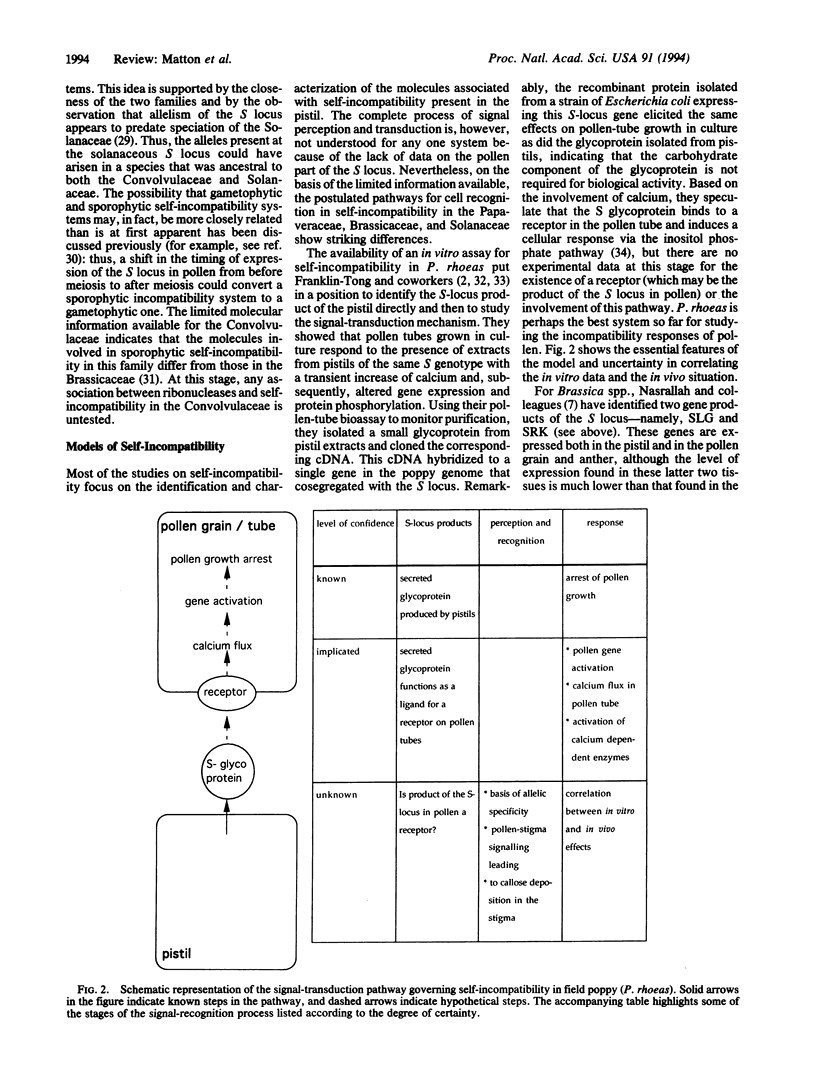
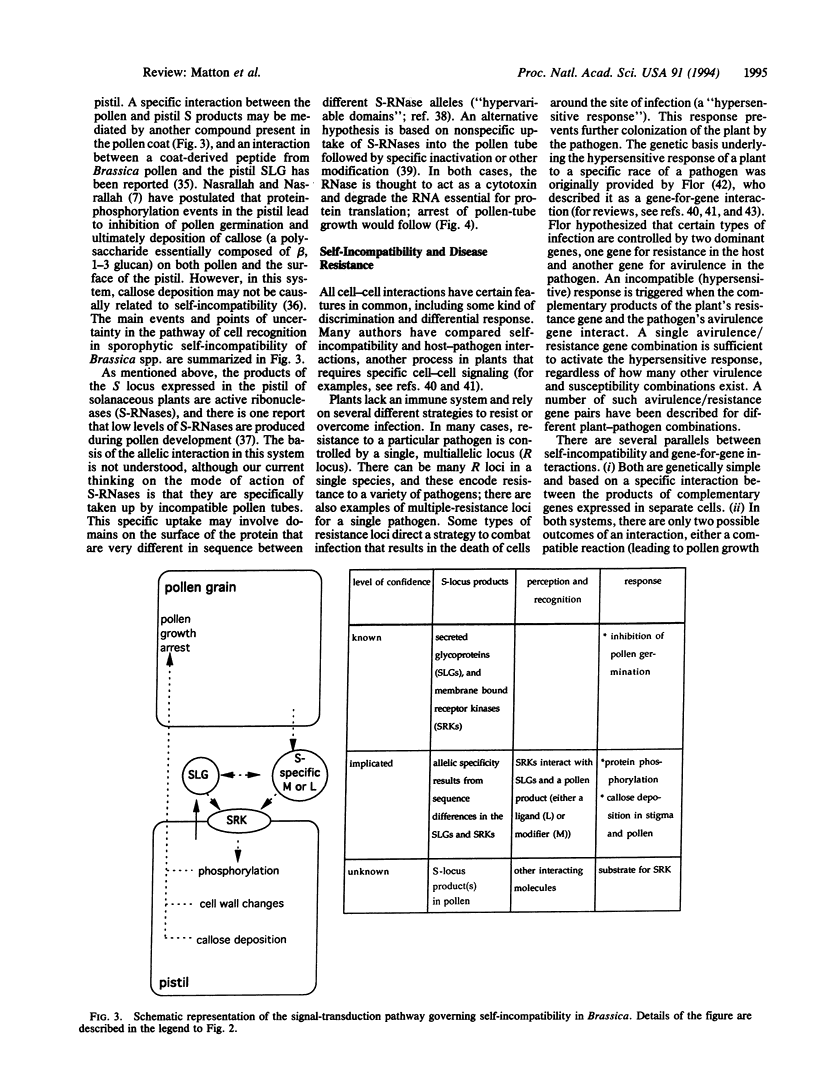
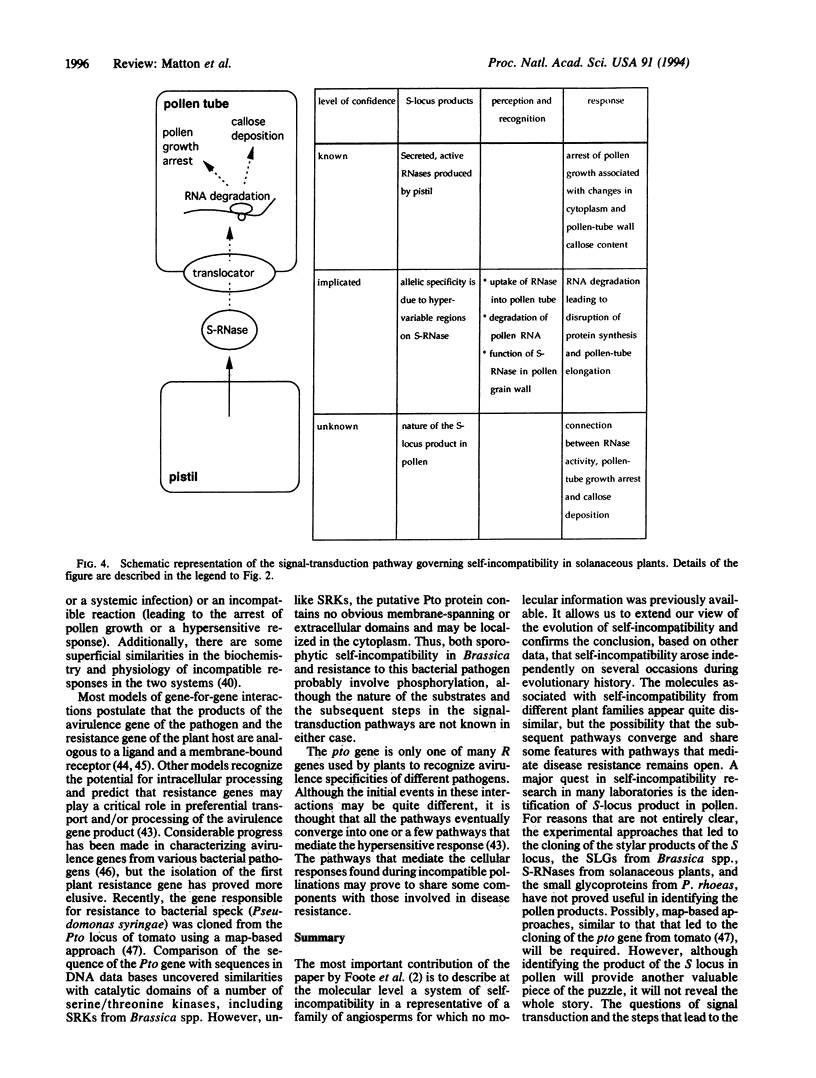
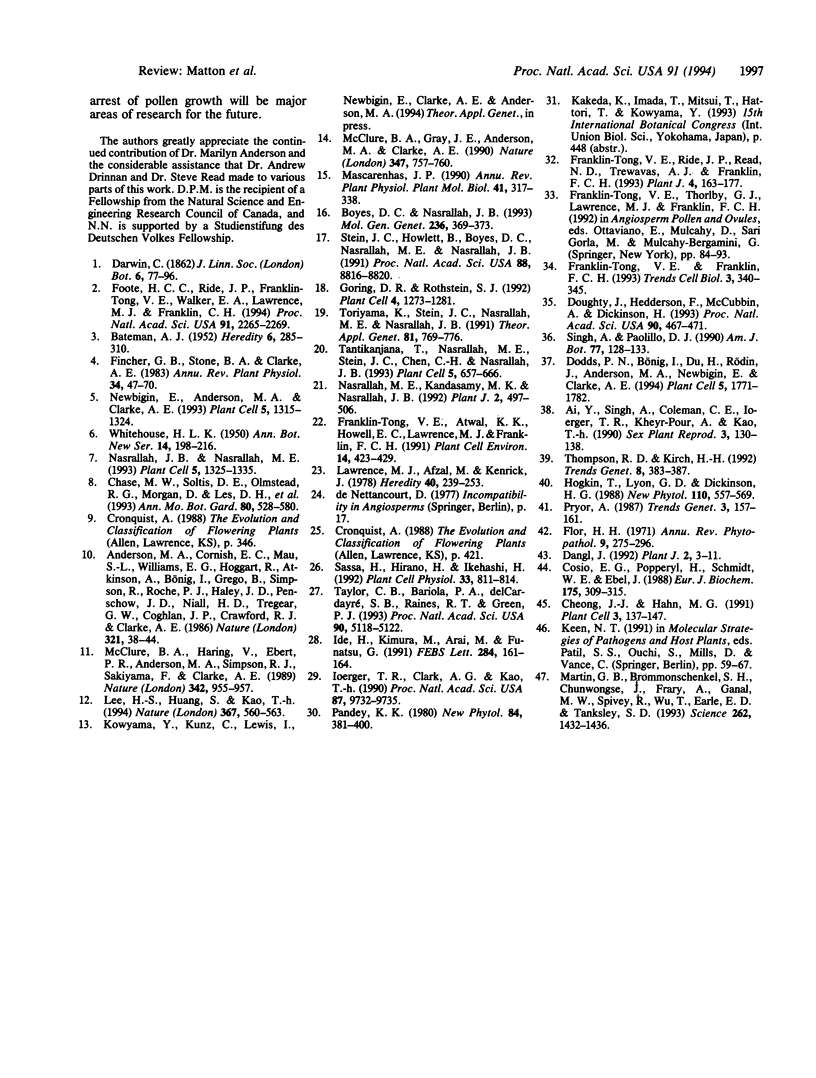
Selected References
These references are in PubMed. This may not be the complete list of references from this article.
- Boyes D. C., Nasrallah J. B. Physical linkage of the SLG and SRK genes at the self-incompatibility locus of Brassica oleracea. Mol Gen Genet. 1993 Jan;236(2-3):369–373. doi: 10.1007/BF00277135. [DOI] [PubMed] [Google Scholar]
- Cheong J. J., Hahn M. G. A specific, high-affinity binding site for the hepta-beta-glucoside elicitor exists in soybean membranes. Plant Cell. 1991 Feb;3(2):137–147. doi: 10.1105/tpc.3.2.137. [DOI] [PMC free article] [PubMed] [Google Scholar]
- Cosio E. G., Pöpperl H., Schmidt W. E., Ebel J. High-affinity binding of fungal beta-glucan fragments to soybean (Glycine max L.) microsomal fractions and protoplasts. Eur J Biochem. 1988 Aug 1;175(2):309–315. doi: 10.1111/j.1432-1033.1988.tb14198.x. [DOI] [PubMed] [Google Scholar]
- Dodds P. N., Bönig I., Du H., Rödin J., Anderson M. A., Newbigin E., Clarke A. E. S-RNase gene of Nicotiana alata is expressed in developing pollen. Plant Cell. 1993 Dec;5(12):1771–1782. doi: 10.1105/tpc.5.12.1771. [DOI] [PMC free article] [PubMed] [Google Scholar]
- Doughty J., Hedderson F., McCubbin A., Dickinson H. Interaction between a coating-borne peptide of the Brassica pollen grain and stigmatic S (self-incompatibility)-locus-specific glycoproteins. Proc Natl Acad Sci U S A. 1993 Jan 15;90(2):467–471. doi: 10.1073/pnas.90.2.467. [DOI] [PMC free article] [PubMed] [Google Scholar]
- Foote H. C., Ride J. P., Franklin-Tong V. E., Walker E. A., Lawrence M. J., Franklin F. C. Cloning and expression of a distinctive class of self-incompatibility (S) gene from Papaver rhoeas L. Proc Natl Acad Sci U S A. 1994 Mar 15;91(6):2265–2269. doi: 10.1073/pnas.91.6.2265. [DOI] [PMC free article] [PubMed] [Google Scholar]
- Franklin-Tong N., Franklin C. Gametophytic self-incompatibility: contrasting mechanisms for Nicotiana and Papaver. Trends Cell Biol. 1993 Oct;3(10):340–345. doi: 10.1016/0962-8924(93)90104-9. [DOI] [PubMed] [Google Scholar]
- Goring D. R., Rothstein S. J. The S-locus receptor kinase gene in a self-incompatible Brassica napus line encodes a functional serine/threonine kinase. Plant Cell. 1992 Oct;4(10):1273–1281. doi: 10.1105/tpc.4.10.1273. [DOI] [PMC free article] [PubMed] [Google Scholar]
- Ide H., Kimura M., Arai M., Funatsu G. The complete amino acid sequence of ribonuclease from the seeds of bitter gourd (Momordica charantia). FEBS Lett. 1991 Jun 24;284(2):161–164. doi: 10.1016/0014-5793(91)80675-s. [DOI] [PubMed] [Google Scholar]
- Ioerger T. R., Clark A. G., Kao T. H. Polymorphism at the self-incompatibility locus in Solanaceae predates speciation. Proc Natl Acad Sci U S A. 1990 Dec;87(24):9732–9735. doi: 10.1073/pnas.87.24.9732. [DOI] [PMC free article] [PubMed] [Google Scholar]
- Lee H. S., Huang S., Kao T. S proteins control rejection of incompatible pollen in Petunia inflata. Nature. 1994 Feb 10;367(6463):560–563. doi: 10.1038/367560a0. [DOI] [PubMed] [Google Scholar]
- Martin G. B., Brommonschenkel S. H., Chunwongse J., Frary A., Ganal M. W., Spivey R., Wu T., Earle E. D., Tanksley S. D. Map-based cloning of a protein kinase gene conferring disease resistance in tomato. Science. 1993 Nov 26;262(5138):1432–1436. doi: 10.1126/science.7902614. [DOI] [PubMed] [Google Scholar]
- McClure B. A., Haring V., Ebert P. R., Anderson M. A., Simpson R. J., Sakiyama F., Clarke A. E. Style self-incompatibility gene products of Nicotiana alata are ribonucleases. Nature. 1989 Dec 21;342(6252):955–957. doi: 10.1038/342955a0. [DOI] [PubMed] [Google Scholar]
- Nasrallah J. B., Nasrallah M. E. Pollen[mdash]Stigma Signaling in the Sporophytic Self-Incompatibility Response. Plant Cell. 1993 Oct;5(10):1325–1335. doi: 10.1105/tpc.5.10.1325. [DOI] [PMC free article] [PubMed] [Google Scholar]
- Newbigin E., Anderson M. A., Clarke A. E. Gametophytic Self-Incompatibility Systems. Plant Cell. 1993 Oct;5(10):1315–1324. doi: 10.1105/tpc.5.10.1315. [DOI] [PMC free article] [PubMed] [Google Scholar]
- Stein J. C., Howlett B., Boyes D. C., Nasrallah M. E., Nasrallah J. B. Molecular cloning of a putative receptor protein kinase gene encoded at the self-incompatibility locus of Brassica oleracea. Proc Natl Acad Sci U S A. 1991 Oct 1;88(19):8816–8820. doi: 10.1073/pnas.88.19.8816. [DOI] [PMC free article] [PubMed] [Google Scholar]
- Tantikanjana T., Nasrallah M. E., Stein J. C., Chen C. H., Nasrallah J. B. An alternative transcript of the S locus glycoprotein gene in a class II pollen-recessive self-incompatibility haplotype of Brassica oleracea encodes a membrane-anchored protein. Plant Cell. 1993 Jun;5(6):657–666. doi: 10.1105/tpc.5.6.657. [DOI] [PMC free article] [PubMed] [Google Scholar]
- Taylor C. B., Bariola P. A., delCardayré S. B., Raines R. T., Green P. J. RNS2: a senescence-associated RNase of Arabidopsis that diverged from the S-RNases before speciation. Proc Natl Acad Sci U S A. 1993 Jun 1;90(11):5118–5122. doi: 10.1073/pnas.90.11.5118. [DOI] [PMC free article] [PubMed] [Google Scholar]
- Thompson R. D., Kirch H. H. The S locus of flowering plants: when self-rejection is self-interest. Trends Genet. 1992 Nov;8(11):381–387. doi: 10.1016/0168-9525(92)90299-j. [DOI] [PubMed] [Google Scholar]


